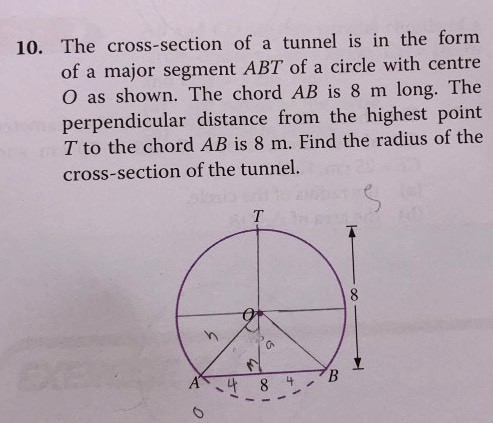Ask Singapore Homework?
Upload a photo of a Singapore homework and someone will email you the solution for free.

Question
secondary 4 | E Maths
One Answer Below
Anyone can contribute an answer, even non-tutors.

hi ! is there a way to find the angle of AOM with only the length of AM ?
∠TMB = 90° since TM ∟ AB. So ∆TMB is a right angled triangle.
tan ∠MTB = MB/MT = 4/8 = ½
so ∠MTB = tan ‾¹ (½) = 26.57° (2d.p)
Now, OB = OT (both are radius of circle)
So ∆ TOB is isosceles.
∠MTB = ∠OTB = 26.57° and thus
∠OTB = ∠ OBT = 26.57° (base ∠s of isosceles ∆)
∠MOB = ∠OTB + ∠OBT = 26.57° + 26.57°
= 53.14°
(exterior angle = sum of two interior opposite angles)
∆MOB is also right angled.
So sin ∠MOB = MB/OB = 4/OB
OB = 4/sin∠MOB = 4/sin53.14°
≈ 4.999m = 5m
OB is a radius of the circle so radius of the cross sectional area is 5m.
(Note that we got 4.999m because the value of ∠MOB was truncated. If we had used OB = 4/sin(2tan‾¹(½) ) and keyed.in directly into the calculator, you will get exactly 5.)
OT + OM = MT
OT + OM = 8
Thus OM = 8 - OT
As TM ∟ AB, TMB = 90° and thus OMB = 90°. So ∆OMB is right angled.
Then OM² + MB² = OB² (Pythagoras' Theorem)
Since OB = OT as both are radius of circle,
OM² + MB² = OT²
Since MB = 4, OM² + 4² = OT²
Sub OM = 8 - OT,
(8 - OT)² + 16 = OT²
64 - 16OT + OT² + 16 = OT²
80 = 16OT
OT = 5
This method utilises Pythagoras Theorem, substitution and the algebraic multiplication formula (a - b)² = a² - 2ab + b² . No need to find angles.
See 1 Answer






